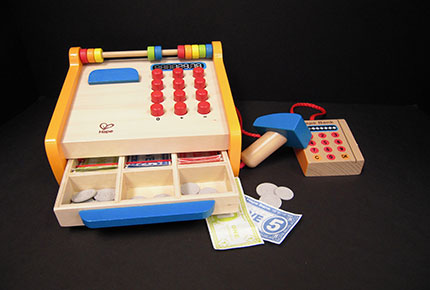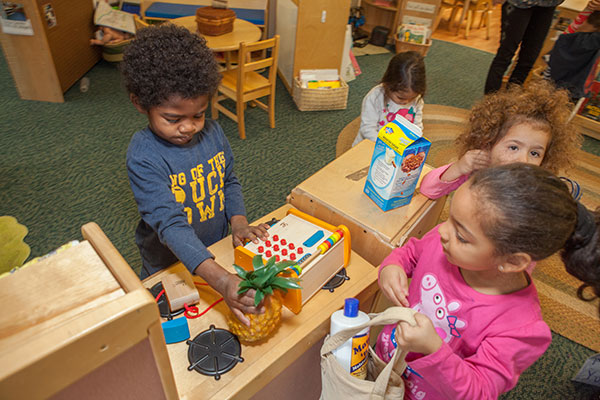TIMPANI Toy Study 2015
(This video has captions. You can turn them on by clicking the CC icon at the bottom of the video.)
Download a printable transcript.
Narrator: The Center for Early Childhood Education at Eastern Connecticut State University is pleased to announce the results of its 2015 TIMPANI Toy Study. The annual study looks at how young children in natural preschool settings play with a variety of toys, and assesses how different types of toys affect the quality of children’s play.
Methods (0:34)
Narrator: Five undergraduate students were responsible for carrying out this year’s study.
Heather Oski, Undergraduate Student Researcher: We came up with ten toys in total, trying to balance the different types of play that we included. Some of the toys were designed for dramatic play centers. We also had some toys that were more constructive, were meant to be built with. Then we also had a puzzles category.
Kristen Krause, Undergraduate Student Researcher: Once the toys are selected, they were brought down, and there’s a schedule in, like, a chart of which toys go to which room. So they were dropped off in each room for the week. We videotape the rooms at the same time each day for a 20-minute segment, and we observe and write down how many kids are playing.
Heather Oski: And later on, we would watch that 20-minute segment using a rubric.
Kristen Krause: It’s an eleven-point rubric, and it’s a one to five scale, five being the highest, one being the lowest.
Heather Oski: We would judge the quality of their play.
Narrator: The rubric allowed researchers to rate how each toy affected children’s play in four broad categories.
Category #1: Thinking and Learning (1:35)
Heather Oski: We wanted to see how well they were actively engaged with the toy and actively constructing new knowledge. We also looked at whether or not they were solving problems or asking questions. The toy that scored the highest in thinking and learning this year was magnetic wooden blocks.
Kristen Krause: The children really had to manipulate to see which side was magnetic and which side repelled, and to be able to build with them and create something.
Boy: I’m gonna make something cool.
Patricia Gardner, Preschool Teacher: There was so much problem solving. You could see that there were children that were going, “Oh, wait; this one doesn’t fit,” and knowing enough that they had to flip it over in order for it to come together.
Patricia Gardner: I noticed a child spending a lot of time just creating a car, and after doing it and finding just the right fit, he was able to use it as a car.
Kristen Krause: The things that they could come up with were really unique, especially compared to playing with regular wooden blocks.
Girl: Say cheese!
Boy: Cheese!
Girl: Janiel, say cheese!
Janiel: Cheese!
Category #2: Creativity and Imagination (2:28)
Kristen Krause: We would look for either really novel uses of the toy, like if they were thinking outside the box and using the toy to do something really different.
Heather Oski: The toy that scored the highest was the pizza play set.
Kristen Krause: The pizza did really well because we saw children take apart the different pieces and use them in very different ways.
Girl: Yeah, I’m making pizza soup.
Niloufar Rezai, Director: Children really had the freedom to build the pizza how they wanted. If the foundation of the pizza was the cheese, for example. Or if they didn’t want cheese, or if they only wanted peppers. So they were really able to be creative with it in that sort of openended way.
Boy: I made pizza! With eyeballs and a mouth.
Heather Oski: They took on different roles. Some people were baking the pizza; some were eating the pizza. I saw one child use an empty bin. They took the bin out, and they took the pizza that they had made, and they used the wooden pizza stone to put it in there and pretended it was an oven.
Niloufar Rezai: I observed children inviting others to come and have pizza with them, and asking them what they wanted on their pizza and how they wanted their pizza.
Boy: Janiel, try this pizza. No, it’s really good – there’s something under it and you can eat it!
Category #3: Social Interaction (3:45)
Kristen Krause: For social interaction we look for if there’s other peers in the area; if they’re interacting with them; if they’re just playing side by side; if they’re ignoring them completely; or if they’re really working cooperatively for the same play theme.
Heather Oski: The toy that scored the highest was a set of four puppets.
Boy: A big bad wolf huffed down my house. Oh dear! What are we going to do?
Heather Oski: The children who had more experience and who were at a higher developmental level were able to use them talking to each other and taking turns, so we saw some conversations.
Girl: Come have a cup with me. But you two, don’t forget the chair.
Heather Oski: One room had this large puppet theater. And the children knew about it so they requested it from the teacher, and as soon as she brought out the puppet theater, the way that the children were playing greatly changed.
Claudia Ahern, Teacher: When the puppet theatre was introduced, their play was more defined.
Boy 2: You can go outside!
Boy 1: With your friends!
Claudia Ahern: There was more of a performance; the language—they used more words. They were able to communicate with the puppets.
Girl 1: Where is my sheep friend?
Girl 2: I’m right here!
Kristen Krause: We saw some children really work together to come to build one dramatic play scheme and really create a story.
Boy: Two little cow, and…
Category #4: Verbalization (5:09)
Kristen Krause: For verbalization we would look for if they were talking at all, making noises...
Heather Oski: Were they having conversations with peers? And were those conversations reciprocal? Or were they just talking at each other? The toy that scored highest was the wooden cash register.
Girl: Here’s four.
Boy: Thank you.
Niloufar Rezai: With a wooden, natural material it didn’t have a lot of the, literally, bells and whistles that most cash registers have, so it really drew children to communicating.
Boy: Beep. Here; I beeped it.
Girl: Credit card.
Boy: No, it’s your credit card.
Niloufar Rezai: The cash register really invited children to engage in pretend play; therefore, it promoted oral language. They had to talk to each other.
Girl: What does this cost? Four dollars, or nine dollars?
Boy: Nine dollars.
Niloufar Rezai: It really invites multiple children to play together cooperatively and negotiate different roles. Someone will have to be the clerk and take the money, and someone will have to be the customer and pay for his or her items.
Boy: And coffee, donuts, and hotdogs.
Other Findings (6:24)
Narrator: This year’s study had several interesting findings. One finding was the importance of dramatic play toys in children’s learning.
Heather Oski: The dramatic play toys gave children opportunities for lots of socialization, lots of language. And when children are working together, they have opportunities to learn from each other.
Niloufar Rezai: Dramatic play is so important because it does invite children to engage with one another to problem solve.
Girl: I can make it! Can I make it?
Niloufar Rezai: There’s only a limited number of roles, so being able to negotiate who will be what, and when, and take turns, and wait, are really important skills at this age.
Boy: Can I buy this? Because I’m at the register.
Niloufar Rezai: And to be able to pretend you’re someone else is very important for children— it helps them to develop their language and their vocabulary related to that particular role.
Girl: Scan the corn. Scan!
Narrator: Another finding from this year’s study was the influence of children’s background knowledge in the quality of their play.
Heather Oski: In this study it was very clear that background knowledge influenced how children were playing with the toys.
Kristen Krause: Especially with dramatic play schemes, background knowledge is really important, because if you don’t have that knowledge, you don’t know what to say or do with your peers. They need to have the knowledge to be able to play with it.
Girl: Neigh! Neigh! Baa! Baa!
2015 TIMPANI Toy (7:52)
Narrator: Each year, one toy is identified as the TIMPANI toy based on its overall score and other criteria. The 2015 TIMPANI toy is the Wooden Cash Register.
Boy: Beep!
Heather Oski: The wooden cash register did well on multiple domains; it did well in creativity and imagination; it did well in social interaction. We also saw both boys and girls playing very well with it. It scored well for children from multiple ethnic and socioeconomic backgrounds.
Niloufar Rezai: They have a lot of background knowledge about cash registers. Most children have been to a store of some kind so they are familiar with how to use it, and the purpose of a cash register. So some of the language was there, and then with teacher scaffolding and observing, they were able to build on some of the language.
Implications for Preschool Classrooms (8:40)
Kristen Krause: Working on this study, I really learned a lot about really looking at toys more in depth, and thinking about different ways you could play with them, and the importance of introducing new toys, and the importance of showing kids what they can do with them, before you put them right in the center. Being able to critically look at that toy, and critically assess a toy.
Claudia Ahern: There is a lot of thought that goes into the selection of the toy; there’s criteria involved. I might feel a toy is really engaging and excellent for developing fine motor skills, and it really depends on the children.
Patricia Gardner: For a toy to be successful or useful, you have to look at the child’s perspective. Children are generally extremely creative, if given the opportunity. There’s a lot of experimentation. And they’re very, very open ended, and those are the kind of toys that do well, or should do well, in a preschool classroom, because there’s so many opportunities for the children to play in different ways.
Heather Oski: Each child is different—they come with different preferences and different ways that they play. So it is good to try to mix things up and to allow children to experience new toys with more knowledgeable peers that they can model and teach with.
Niloufar Rezai: I think it’s important that teachers really take a good look at the materials they are bringing into the classroom. Think about the purpose of the material, observe what children do with the materials, and sort of use that information to change and impact their environment.
Boy 1: Here go.
Boy 2: I need a hundred dollars.




